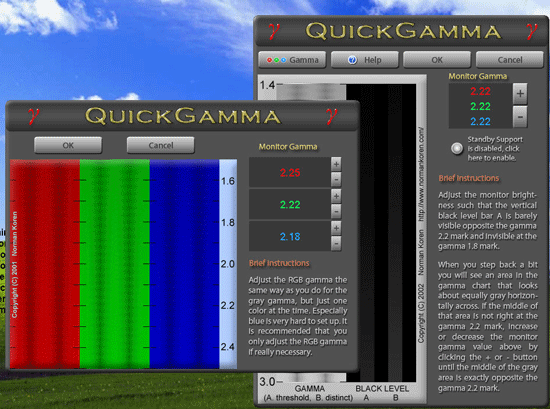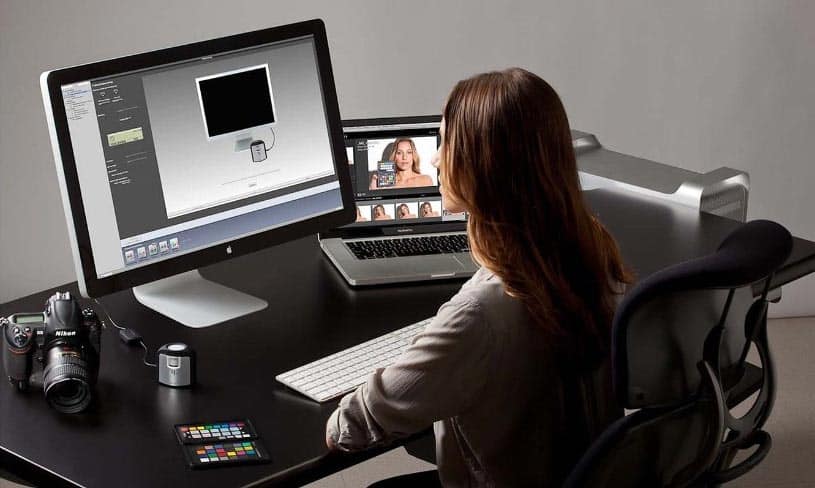Best Color Calibration Tool For Mac
- Best Color Calibration Tool For Macbook Air
- Best Color Calibration For Mac
- Best Color Calibration Tool For Mac Computers
- Color Calibration Tool Laptop
- Best Color Calibration Tool For Monitors
How to Color Calibrate Your Mac’s Display. Posted on November 26th, 2020 by Kirk McElhearn If you only use your Mac for browsing the Web, sending and receiving email, and working in a word processor, it’s probably not all that important for it to display accurate colors. 2) Alternately, you can apply a dedicated Color Viewer LUT for calibration, using?the 1D/3D Color Viewer Lookup Table pop-up menu that’s found in the Color Management panel of the Project Settings. This lets you analyze your computer display for calibration in the same way you would calibrate an external display, using a probe and color.
When starting out as a designer and creative it may seem like it doesn’t matter too much to calibrate your monitor. Most monitors come calibrated right out of the box so, well, they probably look fine enough, at least for a little while. However, the more you work as a designer and develop your eye you can understand why serious designers always calibrate their monitors and suggest it to other designers to definitely do as well.
As designers, you have a few core things you explore and develop strength in as visual communicators. You work with visual concepts, typography, layout, materials. and most importantly, you work with color. A good color palette is essential to a top quality design. So, color is not an area to guess on when working on your new favorite project. Oftentimes, color is the special sauce that takes a design from OK to great. Color is even more important to get right when you are working in print. The color should match from screen to print as well as possible. It is futile to spend hours on a design that onscreen will resemble nothing like the final print product. So, color calibration is key.
Color Calibration on your Computer
The first step is to ensure you have calibrated the color on your monitor using the calibration tools in your OS.
- In Windows 10, you can go to System, then click Display > Advanced Display Settings > Color Calibration. Once you are there run the tool to get the best possible results. If you have two monitors you need to run it on both monitors. Matching your monitors color will also help with your workflow as you move back and forth from screen to screen.
- On MacOS, click Settings and choose Display then the Color tab and the Calibrate button.
Hardware Calibration
For accurate color matching your best bet is a hardware calibration tool. The subject of hardware calibration and optimizing monitors is in fact quite complex, for the purposes of this article I am going to focus on the most common scenario for designers who may be using a basic or medium range monitor. Here are a few options that are very good colorimeters for 2017:
Spyder5Express
The Spyder5 calibration tools are now the leading ones in use. For years, Pantone and its products were the go-to for color calibration. Now there are more options on the market and many good models from Spyder5. The Express version is a good entry calibration tool for hobbyists and will help one have consistent color across monitors and laptops, but it lacks some of the features of other Spyder models.
Spyder5Pro
For serious designers and photographers the SpyderPro gives you everything one needs for full-featured and advanced color accuracy. The Pro version includes advanced calibration settings for gamma, white point and gray balance, and has 16 pre-installed calibration setting choices.
Spyder5Elite
The Syper5 Elite is for photographers, designers, and colorists and is different than the other versions because it supports unlimited calibration settings and calibrates across monitors, studio monitors, laptops, and projectors. If you want optimal calibration and enhanced work flow this is the best choice of the Spyder calibration tools.
ColorMunki Display X-Rite
The ColorMunki X-Rite is a good choice for expert amateurs and some professional designers. The best thing about this option is that its easy to set up and ensures pretty good color, it does not offer a lot of nuanced calibration options though. The price is very good though for what you are getting with this calibration tool. If you have a laptop this is considered a very good choice.
X-Rite i1Display Pro
The display pro is considered an industry standard calibrator and a professional’s choice. It uses its own exclusive technology to deliver excellent color matching results across a range of monitor types like LED, Plasma, and Wide Gamut. It is also optimized for use with Pantone Spot Colors. The drawback of this solution is that the interface may be a bit complex and it is a bit more expensive.
You can find any one of these calibration tools at Amazon or B&H Photo. Color and calibration is an interesting subject, as designers, photographers and artists you may be interested to learn more on your own. Here are some additional resources to explore:
How to Calibrate your Monitor, Digital Trends.
Monitor Calibration for Photographers, Cambridge in Color.
The Benefits of Color Calibration, PhotoFocus.
Photo for this article is by Nicolas Ladino Silva on Unsplash.
Margaret Penney is the Managing Editor of Notes on Design. Margaret is a teacher, designer, writer and new media artist and founder of Hello Creative Co.
Best Color Calibration Tool For Macbook Air
If you are interested in learning more about using color, Sessions College offers a Color Theory course and many other graphic design courses for students at all levels. Contact Admissions for more information.

Recent Articles
Related Content
Using professional color calibration software, you can correctly calibrate the colors on your monitor, which will later help you perform accurate color correction of photos/videos and also have a huge impact on the aesthetic beauty of your design templates or graphic elements. Calibrate colors automatically or manually in a few steps.
Top 5 Color Calibration Software
- Calibrize - 2-step color calibration
- Windows Native - To save different profiles
- QuickGamma - Preview lines
- Lagom LCD monitor - Online test with instructions
- CalMAN ColorMatch - Calibrating 4K projectors and displays
While working on laptops and PCs running Windows, users often encounter problems with the incorrect color calibration of the display. You can make colors more saturated, brighter, add contrast or eliminate dull shades on your CRT and LCD monitors. Replace expensive, physical monitor calibrators with these color calibration software.

1. Calibrize - Our Choice
- 2-step screen calibration
- Re-calibration reminders
- Helpful reference documentation
- Not found
Verdict: Calibrize is a free monitor calibration tool that allows coping with the task in two steps. You can maximize the contrast level and adjust clarity, as well as customize the gamma, by dragging three sliders that affect the red, blue and green channels.
It offers regular color re-calibration reminders, displays simple instructions, and provides additional online help documentation. No special skills required. Calibrize uses a minimum of system resources and doesn’t require a system reboot to apply new changes. Fifa 16 serial key no survey.
2. Windows Native
- No download required
- Saves settings as profiles
- In-depth instructions
- Can’t show the Before & After screen
Verdict: You don't need to use expensive monitors for photo editing, as the built-in display color calibration tool on Windows 10 offers the most detailed setup instructions. Enter 'Color Calibration' in the search bar and select the gamma, brightness, contrast and color balance settings for your display.
A sample image that you can create will accompany many customizations. After the calibration wizard finishes the work, be sure to select the current version of the calibration or return to the previous one if you are not satisfied with the results. The new calibration will be saved as an .ics file or color calibration file and displayed as a new ICC profile.
3. QuickGamma
- Interactive calibration charts
- RBG gamut
- Preview
- Outdated design
Best Color Calibration For Mac
Verdict: QuickGamma is a utility designed to quickly calibrate your monitor without having to buy any hardware tools. The program provides interactive calibration charts for black/gray settings as well as RGB gamma.
The preview section displays the outer and inner stripes with the same gray levels, as well as two black levels, so you can better understand how the changes affect the display. Red, green, and blue channels can be changed together, or you can press the dedicated Gamma button to control them individually, while tracking the changes using the other displayed preview section.
4. Lagom LCD monitor
- You can download test images
- Doesn’t require downloading
- Detailed descriptions of the sequence of actions
- Setting according to one pattern
Verdict: The Lagom LCD monitor is an online site that includes a series of test images from which you can calibrate your monitor by adjusting the brightness, contrast, sync/phase, sharpness and gamma of the display.
In total, this screen calibration software offers 15 images that are accompanied by a small description, according to which you need to adjust one or another parameter of your monitor. You’d better look at these images in a dim or dark room and in full-screen mode. You can take a look at the images provided on the web page and also save them on a USB drive to try them on your computer.
Best Color Calibration Tool For Mac Computers
5. CalMAN ColorMatch
- Possible calibration of projectors
- Setting up 4K displays
- Calibrates saturation for each color
Color Calibration Tool Laptop
- Complex software to master
Verdict: Calman is the most widely-used color calibration software to test display performance. Depending on the version you choose, you will be able to profile your display or use software to calibrate projectors and professional monitors for video editing up to 4K UHD.
Best Color Calibration Tool For Monitors
Another notable feature is 3D LUT support; also known as Color Cube. This is an AutoCal procedure when Calman calibrates multiple saturation levels for each primary and secondary color. While no displays support this, there are some external video processors that do.